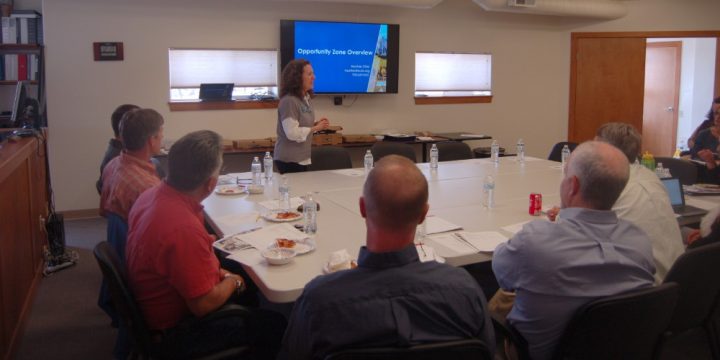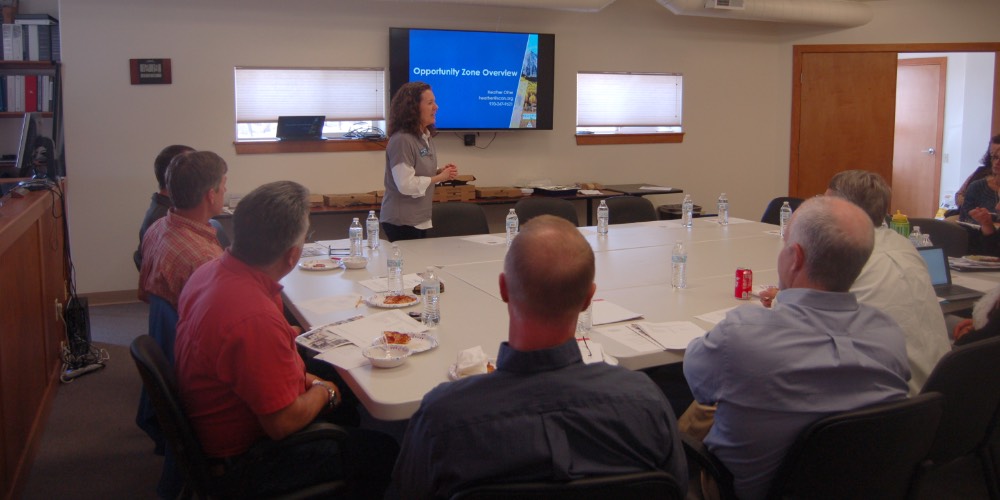As it turned out, yesterday’s March 26 joint meeting — with the Pagosa Springs Town Council and Archuleta Board of County Commissioners — included some storytelling, but not much in the way of real conversations.
A real conversation, meaning: a back and forth sharing of ideas, where everyone learns something about the other people in the room.
The Town Council fielded only two of its seven members for yesterday’s meeting, while the BOCC had all three commissioners in attendance. It’s been my recent experience that the Town Council, as a group, tends to engage in real conversations, while the BOCC, as a group, does not. Perhaps the lack of Town Council members contributed to the dearth of interesting discussion yesterday?
But it could also have been the result of the agenda, focused as it was on presentations by outside agencies… which included Region 9 Economic Development District and the Pagosa Springs Community Development District.
We heard, for example, about Opportunity Zones — OZ, for short — the new tax incentive program created by the federal government in 2017. Yesterday’s overview by Region 9 Project Manager Heather Otter was very similar to what some of us had heard last month, at a Region 9 ‘OZ’ presentation that few if any local government leaders had attended.
As we see in the photo, there were a fair number of empty seats at the table for Ms. Otter’s lunchtime presentation. In fact, the BOCC had provided nearly as many full pizza boxes as there were elected leaders at the meeting.

As I mentioned in Part One, you can read an overview of that February ‘OZ’ event in this Daily Post editorial.
The ‘OZ’ program was part of the federal tax overhaul passed by a Republican Congress and administration in 2017, before the Democrats took control of the US House of Representatives. Apparently, South Carolina Republican Senator Tim Scott was instrumental in designing this new program, which will provide hefty tax credits to wealthy investors, when they invest in businesses within certain ‘economically challenged’ geographical areas.
A few excerpts from an email we received, from Senator Scott’s office:
Good afternoon and happy Friday from the communications office of U.S. Senator Tim Scott.
We’re just here to let you know about all the good news from around the country surrounding Senator Scott’s Opportunity Zone initiative…
It’s true, California Democrat Governor Newsom thinks that Opportunity Zones will spur investment into low-income communities in the Golden State. “A lot of us, at least on my side of the political aisle said, ‘That actually sounds like a good idea. Wait a second, it came out of which administration? I’m still trying to get my arms around it. Maybe it’s too good of an idea…’”
Clark County, Washington is revitalizing low-income neighborhoods like Vancouver and Washougal. Don’t believe us? Ask Vancouver Downtown Redevelopment Authority President Richard Keller: “It’s an absolute no-brainer, and a real gift from the federal government and will give us a real shot in the arm in these areas…”
Up to 3,000 (!!) jobs may be on their way to East Chicago with the news coming out of the Lake County Economic Alliance…
The Kresge Foundation is looking to support two socially conscious investment funds hoping to pour $800 million into manufacturing, clean energy, and other business development in Opportunity Zones — like a solar farm in Flint, Michigan.
Arizona’s in play too: Virtua Partners has 15 projects in the Phoenix area…
Folks in Los Angeles think that Opportunity Zones can help with their housing crisis…
Senator Scott’s office is “expecting the second tranche of proposed regulations to come out of the Treasury Department any day now.” Which is probably a good thing, because the OZ program involves a lot of complex and confusing details that have yet to be clarified by the IRS.
But before we heard from Ms. Otter about OZ opportunities and complexities, the joint meeting got a brief summary of Region 9 activities in Archuleta County from Executive Director Laura Lewis Marchino. A few business loans made, some business advice offered, Enterprise Zone contributions tracked. That sort of thing.
Ms. Lewis Marchino began her presentation by referring her data as “the boring stuff.”
“I know there’s more interest in the Opportunity Zone, so I was going to do the kind of boring stuff first, if that’s alright? … It looks like you guys already have a copy of the Performance Report?”
The Performance Report notes that Region 9 is celebrating its 30th year helping to enhance the business climate in five Southwest Colorado counties. Most of its successes have taken place in the most populous of those rural counties: neighboring La Plata County. According to their new annual report, very little economic benefits have been seen in Dolores County or San Juan County, while in the other three counties — Archuleta, La Plata and Montezuma — we’ve seen over 6,000 new jobs created since 1998.
But job creation seems to have slowed somewhat? Back in the three year period of 1998-2000, the region saw about 2,100 new jobs, according to Region 9 figures. During the most recent three-year period, however, only about 730 new jobs appeared. While the region’s population appears to be growing, we are not seeing similar growth rate in the employment numbers. Or so it might seem.
“Opportunity Zones” to the rescue? (Not likely, in my humble opinion.)
From the Archuleta County Performance Report, (which you can download here):
In the past 29 years, Region 9 provided business loans totaling over $2,019,022 resulting in 116 jobs in Archuleta County. In 2018, the County generated 3 inquiries to Region 9 resulting in 1 new loan, and 2 loans paid off.
$2 million in small business loans, over a 29 year period, comes to about $70,000 a year. For comparison, that’s much less than one typical single-family home mortgage loan in Archuleta County. But that’s just for comparison. It’s much harder to get a loan for a small business than for a home purchase, because small businesses often fail — while a house remains valuable even if the borrower defaults on the loan.
The next presentation, on Tuesday, concerned $200,000 in local government subsidies provided to the Pagosa Springs Community Development Corporation…

